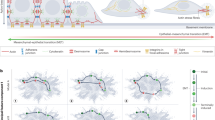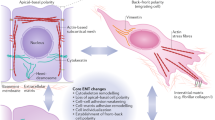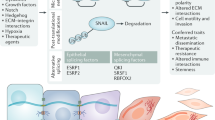Abstract
Epithelial–mesenchymal transition (EMT) is a phenotypic conversion that facilitates organ morphogenesis and tissue remodeling in physiological processes, such as embryonic development and wound healing. A similar phenotypic conversion is also detected in fibrotic diseases and neoplasia, and is associated with disease progression. EMT in cancer epithelial cells often seems to be an incomplete and bidirectional process. In this Review, we discuss the phenomenon of EMT as it pertains to tumor development, focusing on exceptions to the commonly held rule that EMT promotes invasion and metastasis. We also highlight the role of RAS-controlled signaling mediators, ERK1, ERK2 and phosphatidylinositol 3-kinase, as microenvironmental responsive regulators of EMT.
Key Points
-
Fibroblast activity (e.g. desmoplasia and stromal transcriptomes) are associated with poor outcome in cancers
-
Epithelial–mesenchymal transition (EMT) of epithelial cancer cells contributes to this activity in the peritumor stroma, and EMT is a subset of the more generalized cell phenotype plasticity exhibited by aggressive tumor cells
-
Clear evidence for EMT of tumor cells in human tumors is rare, and this might be owing to its transient and dynamic nature
-
The clinical significance of EMT is still under study but has been associated with the metastatic/invasive phenotype and specific breast carcinoma subtypes
-
Study of EMT has focused on its role in active dissemination of tumor cells (e.g. migration and invasion), but emerging evidence suggests a broader functional role in tumor progression, including drug resistance and immune modulation
-
RAS-regulated pathways connect regulation of EMT to the tumor microenvironment
This is a preview of subscription content, access via your institution
Access options
Subscribe to this journal
Receive 12 print issues and online access
$209.00 per year
only $17.42 per issue
Buy this article
- Purchase on Springer Link
- Instant access to full article PDF
Prices may be subject to local taxes which are calculated during checkout





Similar content being viewed by others
References
Lee JM et al. (2006) The epithelial-mesenchymal transition: new insights in signaling, development, and disease. J Cell Biol 172: 973–981
Valles AM et al. (1990) Acidic fibroblast growth factor is a modulator of epithelial plasticity in a rat bladder carcinoma cell line. Proc Natl Acad Sci USA 87: 1124–1128
Kalluri R and Neilson EG (2003) Epithelial-mesenchymal transition and its implications for fibrosis. J Clin Invest 112: 1776–1784
Desmouliere A et al. (2004) The stroma reaction myofibroblast: a key player in the control of tumor cell behavior. Int J Dev Biol 48: 509–517
Nuyten DS et al. (2006) Predicting a local recurrence after breast-conserving therapy by gene expression profiling. Breast Cancer Res 8: R62
Chang HY et al. (2004) Gene expression signature of fibroblast serum response predicts human cancer progression: similarities between tumors and wounds. PLoS Biol 2: E7
Chang HY et al. (2005) Robustness, scalability, and integration of a wound-response gene expression signature in predicting breast cancer survival. Proc Natl Acad Sci USA 102: 3738–3743
Radisky DC et al. (2007) Fibrosis and cancer: do myofibroblasts come also from epithelial cells via EMT? J Cell Biochem 101: 830–839
Adler AS and Chang HY (2006) From description to causality: mechanisms of gene expression signatures in cancer. Cell Cycle 5: 1148–1151
Liu ET et al. (2006) In the pursuit of complexity: systems medicine in cancer biology. Cancer Cell 9: 245–247
Thiery JP (2003) Epithelial-mesenchymal transitions in development and pathologies. Curr Opin Cell Biol 15: 740–746
Hay ED (1995) An overview of epithelio-mesenchymal transformation. Acta Anat (Basel) 154: 8–20
McAnulty RJ (2007) Fibroblasts and myofibroblasts: their source, function and role in disease. Int J Biochem Cell Biol 39: 666–671
Willis BC et al. (2006) Epithelial origin of myofibroblasts during fibrosis in the lung. Proc Am Thorac Soc 3: 377–382
Neilson EG (2006) Mechanisms of Disease: fibroblasts—a new look at an old problem. Nat Clin Pract Nephrol 2: 101–108
Faulkner JL et al. (2005) Origin of interstitial fibroblasts in an accelerated model of angiotensin II-induced renal fibrosis. Am J Pathol 167: 1193–1205
Liu Y (2004) Epithelial to mesenchymal transition in renal fibrogenesis: pathologic significance, molecular mechanism, and therapeutic intervention. J Am Soc Nephrol 15: 1–12
Zvaifler NJ (2006) Relevance of the stroma and epithelial-mesenchymal transition (EMT) for the rheumatic diseases. Arthritis Res Ther 8: 210
Vincent-Salomon A and Thiery JP (2003) Host microenvironment in breast cancer development: epithelial-mesenchymal transition in breast cancer development. Breast Cancer Res 5: 101–106
Zhang Z et al. (2001) Transdifferentiation of neoplastic cells. Med Hypotheses 57: 655–666
Katoh M (2005) Epithelial-mesenchymal transition in gastric cancer. Int J Oncol 27: 1677–1683
Bates RC and Mercurio AM (2005) The epithelial-mesenchymal transition (EMT) and colorectal cancer progression. Cancer Biol Ther 4: 365–370
Yang J et al. (2006) Exploring a new twist on tumor metastasis. Cancer Res 66: 4549–4552
Kalluri R and Zeisberg M (2006) Fibroblasts in cancer. Nat Rev Cancer 6: 392–401
Thiery JP and Sleeman JP (2006) Complex networks orchestrate epithelial-mesenchymal transitions. Nat Rev Mol Cell Biol 7: 131–142
Boyer B et al. (1989) Reversible transition towards a fibroblastic phenotype in a rat carcinoma cell line. Int J Cancer Suppl 4: 69–75
Nelson CM et al. (2006) Tissue geometry determines sites of mammary branching morphogenesis in organotypic cultures. Science 314: 298–300
Jechlinger M et al. (2003) Expression profiling of epithelial plasticity in tumor progression. Oncogene 22: 7155–7169
LaGamba D et al. (2005) Microarray analysis of gene expression during epithelial-mesenchymal transformation. Dev Dyn 234: 132–142
Roepman P et al. (2006) Maintenance of head and neck tumor gene expression profiles upon lymph node metastasis. Cancer Res 66: 11110–11114
Bacac M et al. (2006) A mouse stromal response to tumor invasion predicts prostate and breast cancer patient survival. PLoS ONE 1: e32
Brabletz T et al. (2005) Invasion and metastasis in colorectal cancer: epithelial-mesenchymal transition, mesenchymal-epithelial transition, stem cells and beta-catenin. Cells Tissues Organs 179: 56–65
Christiansen JJ and Rajasekaran AK (2006) Reassessing epithelial to mesenchymal transition as a prerequisite for carcinoma invasion and metastasis. Cancer Res 66: 8319–8326
Fridriksdottir AJ et al. (2005) Maintenance of cell type diversification in the human breast. J Mammary Gland Biol Neoplasia 10: 61–74
Petersen OW et al. (2001) The plasticity of human breast carcinoma cells is more than epithelial to mesenchymal conversion. Breast Cancer Res 3: 213–217
Gudjonsson T et al. (2005) Myoepithelial cells: their origin and function in breast morphogenesis and neoplasia. J Mammary Gland Biol Neoplasia 10: 261–272
Adriance MC et al. (2005) Myoepithelial cells: good fences make good neighbors. Breast Cancer Res 7: 190–197
Petersen OW et al. (2003) Epithelial to mesenchymal transition in human breast cancer can provide a nonmalignant stroma. Am J Pathol 162: 391–402
Tarin D et al. (2005) The fallacy of epithelial mesenchymal transition in neoplasia. Cancer Res 65: 5996–6000
Spaderna S et al. (2006) A transient, EMT-linked loss of basement membranes indicates metastasis and poor survival in colorectal cancer. Gastroenterology 131: 830–840
Alonso SR et al. (2007) A high-throughput study in melanoma identifies epithelial-mesenchymal transition as a major determinant of metastasis. Cancer Res 67: 3450–3460
Lien HC et al. (2007) Molecular signatures of metaplastic carcinoma of the breast by large-scale transcriptional profiling: identification of genes potentially related to epithelial-mesenchymal transition. Oncogene 26: 7859–7871
Chung CH et al. (2006) Gene expression profiles identify epithelial-to-mesenchymal transition and activation of nuclear factor-κB signaling as characteristics of a high-risk head and neck squamous cell carcinoma. Cancer Res 66: 8210–8218
Barrallo-Gimeno A and Nieto MA (2005) The Snail genes as inducers of cell movement and survival: implications in development and cancer. Development 132: 3151–3161
Fournier MV et al. (2006) Gene expression signature in organized and growth-arrested mammary acini predicts good outcome in breast cancer. Cancer Res 66: 7095–7102
van't Veer LJ et al. (2002) Gene expression profiling predicts clinical outcome of breast cancer. Nature 415: 530–536
Chaffer CL et al. (2006) Mesenchymal-to-epithelial transition facilitates bladder cancer metastasis: role of fibroblast growth factor receptor-2. Cancer Res 66: 11271–11278
Nieuwenhuis MH et al. (2007) Genotype-phenotype correlations as a guide in the management of familial adenomatous polyposis. Clin Gastroenterol Hepatol 5: 374–378
Han G et al. (2005) Distinct mechanisms of TGF-beta1-mediated epithelial-to-mesenchymal transition and metastasis during skin carcinogenesis. J Clin Invest 115: 1714–1723
Zavadil J et al. (2001) Genetic programs of epithelial cell plasticity directed by transforming growth factor-beta. Proc Natl Acad Sci USA 98: 6686–6691
Flanders KC (2004) Smad3 as a mediator of the fibrotic response. Int J Exp Pathol 85: 47–64
Hudson LG et al. (2007) Ultraviolet radiation stimulates expression of Snail family transcription factors in keratinocytes. Mol Carcinog 46: 257–268
Prindull G and Zipori D (2004) Environmental guidance of normal and tumor cell plasticity: epithelial mesenchymal transitions as a paradigm. Blood 103: 2892–2899
Rastaldi MP (2006) Epithelial-mesenchymal transition and its implications for the development of renal tubulointerstitial fibrosis. J Nephrol 19: 407–412
Savagner P et al. (2005) Developmental transcription factor slug is required for effective re-epithelialization by adult keratinocytes. J Cell Physiol 202: 858–866
Yauch RL et al. (2005) Epithelial versus mesenchymal phenotype determines in vitro sensitivity and predicts clinical activity of erlotinib in lung cancer patients. Clin Cancer Res 11: 8686–8698
Thomson S et al. (2005) Epithelial to mesenchymal transition is a determinant of sensitivity of non-small-cell lung carcinoma cell lines and xenografts to epidermal growth factor receptor inhibition. Cancer Res 65: 9455–9462
Hiscox S et al. (2006) Tamoxifen resistance in MCF7 cells promotes EMT-like behaviour and involves modulation of beta-catenin phosphorylation. Int J Cancer 118: 290–301
Carrozzino F et al. (2005) Inducible expression of Snail selectively increases paracellular ion permeability and differentially modulates tight junction proteins. Am J Physiol Cell Physiol 289: C1002–C1014
Aroeira LS et al. (2005) Mesenchymal conversion of mesothelial cells as a mechanism responsible for high solute transport rate in peritoneal dialysis: role of vascular endothelial growth factor. Am J Kidney Dis 46: 938–948
Parsonage G et al. (2005) A stromal address code defined by fibroblasts. Trends Immunol 26: 150–156
Hogaboam CM et al. (1998) Novel roles for chemokines and fibroblasts in interstitial fibrosis. Kidney Int 54: 2152–2159
Strutz F et al. (2001) TGF-beta 1 induces proliferation in human renal fibroblasts via induction of basic fibroblast growth factor (FGF-2). Kidney Int 59: 579–592
Wu WS (2006) The signaling mechanism of ROS in tumor progression. Cancer Metastasis Rev 25: 695–705
Larue L and Bellacosa A (2005) Epithelial-mesenchymal transition in development and cancer: role of phosphatidylinositol 3[prime] kinase/AKT pathways. Oncogene 24: 7443–7454
Malaney S and Daly RJ (2001) The ras signaling pathway in mammary tumorigenesis and metastasis. J Mammary Gland Biol Neoplasia 6: 101–113
Huber MA et al. (2005) Molecular requirements for epithelial-mesenchymal transition during tumor progression. Curr Opin Cell Biol 17: 548–558
Bild AH et al. (2006) Linking oncogenic pathways with therapeutic opportunities. Nat Rev Cancer 6: 735–741
Massague J (2007) Sorting out breast-cancer gene signatures. N Engl J Med 356: 294–297
Chambard JC et al. (2007) ERK implication in cell cycle regulation. Biochim Biophys Acta 1773: 1299–1310
Giehl K (2005) Oncogenic Ras in tumour progression and metastasis. Biol Chem 386: 193–205
Nottage M and Siu LL (2002) Rationale for Ras and raf-kinase as a target for cancer therapeutics. Curr Pharm Des 8: 2231–2242
Guerra E et al. (2003) Prognostic value of mutations in TP53 and RAS genes in breast cancer. Int J Biol Markers 18: 49–53
Kim D et al. (2005) Targeting the phosphatidylinositol-3 kinase/Akt pathway for the treatment of cancer. Curr Opin Investig Drugs 6: 1250–1258
Milde-Langosch K et al. (2005) Expression and prognostic relevance of activated extracellular-regulated kinases (ERK1/2) in breast cancer. Br J Cancer 92: 2206–2215
Gee JM et al. (2000) Biological and clinical associations of c-jun activation in human breast cancer. Int J Cancer 89: 177–186
Gee JM et al. (2001) Phosphorylation of ERK1/2 mitogen-activated protein kinase is associated with poor response to anti-hormonal therapy and decreased patient survival in clinical breast cancer. Int J Cancer 95: 247–254
Janes PW et al. (1994) Activation of the Ras signalling pathway in human breast cancer cells overexpressing erbB-2. Oncogene 9: 3601–3608
Nakopoulou L et al. (2005) Effect of different ERK2 protein localizations on prognosis of patients with invasive breast carcinoma. APMIS 113: 693–701
Janda E et al. (2002) Ras and TGFβ cooperatively regulate epithelial cell plasticity and metastasis: dissection of Ras signaling pathways. J Cell Biol 156: 299–313
Grunert S et al. (2003) Diverse cellular and molecular mechanisms contribute to epithelial plasticity and metastasis. Nat Rev Mol Cell Biol 4: 657–665
Shintani Y et al. (2006) Phosphoinositide-3 kinase-Rac1-c-Jun NH2-terminal kinase signaling mediates collagen I-induced cell scattering and up-regulation of N-cadherin expression in mouse mammary epithelial cells. Mol Biol Cell 17: 2963–2975
Zavadil J and Bottinger EP (2005) TGF-beta and epithelial-to-mesenchymal transitions. Oncogene 24: 5764–5774
Nawshad A et al. (2005) Transforming growth factor-beta signaling during epithelial-mesenchymal transformation: implications for embryogenesis and tumor metastasis. Cells Tissues Organs 179: 11–23
Lochter A et al. (1997) Misregulation of stromelysin-1 expression in mouse mammary tumor cells accompanies acquisition of stromelysin-1-dependent invasive properties. J Biol Chem 272: 5007–5015
Lochter A et al. (1997) Matrix metalloproteinase stromelysin-1 triggers a cascade of molecular alterations that leads to stable epithelial-to-mesenchymal conversion and a premalignant phenotype in mammary epithelial cells. J Cell Biol 139: 1861–1872
Radisky DC et al. (2005) Rac1b and reactive oxygen species mediate MMP-3-induced EMT and genomic instability. Nature 436: 123–127
Savagner P (2001) Leaving the neighborhood: molecular mechanisms involved during epithelial-mesenchymal transition. Bioessays 23: 912–923
Tibbles LA and Woodgett JR (1999) The stress-activated protein kinase pathways. Cell Mol Life Sci 55: 1230–1254
Scaltriti M and Baselga J (2006) The epidermal growth factor receptor pathway: a model for targeted therapy. Clin Cancer Res 12: 5268–5272
Tolg C et al. (2006) Rhamm−/− fibroblasts are defective in CD44-mediated ERK1,2 motogenic signaling, leading to defective skin wound repair. J Cell Biol 175: 1017–1028
Liu R et al. (2007) The prognostic role of gene signature from tumorigenic breast cancer cells. N Engl J Med 356: 217–226
Author information
Authors and Affiliations
Corresponding author
Ethics declarations
Competing interests
The authors declare no competing financial interests.
Rights and permissions
About this article
Cite this article
Turley, E., Veiseh, M., Radisky, D. et al. Mechanisms of Disease: epithelial–mesenchymal transition—does cellular plasticity fuel neoplastic progression?. Nat Rev Clin Oncol 5, 280–290 (2008). https://doi.org/10.1038/ncponc1089
Received:
Accepted:
Published:
Issue Date:
DOI: https://doi.org/10.1038/ncponc1089
This article is cited by
-
Mesenchymal stem cell-released oncolytic virus: an innovative strategy for cancer treatment
Cell Communication and Signaling (2023)
-
Glycosphingolipids in human embryonic stem cells and breast cancer stem cells, and potential cancer therapy strategies based on their structures and functions
Glycoconjugate Journal (2022)
-
CircMEMO1 modulates the promoter methylation and expression of TCF21 to regulate hepatocellular carcinoma progression and sorafenib treatment sensitivity
Molecular Cancer (2021)
-
Serum level of cytokeratin 19 as a diagnostic and prognostic marker in patients with HCV-related hepatocellular carcinoma
Egyptian Liver Journal (2021)
-
ARID1A prevents squamous cell carcinoma initiation and chemoresistance by antagonizing pRb/E2F1/c-Myc-mediated cancer stemness
Cell Death & Differentiation (2020)



